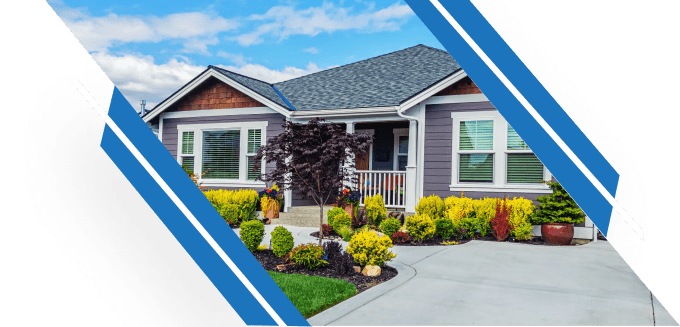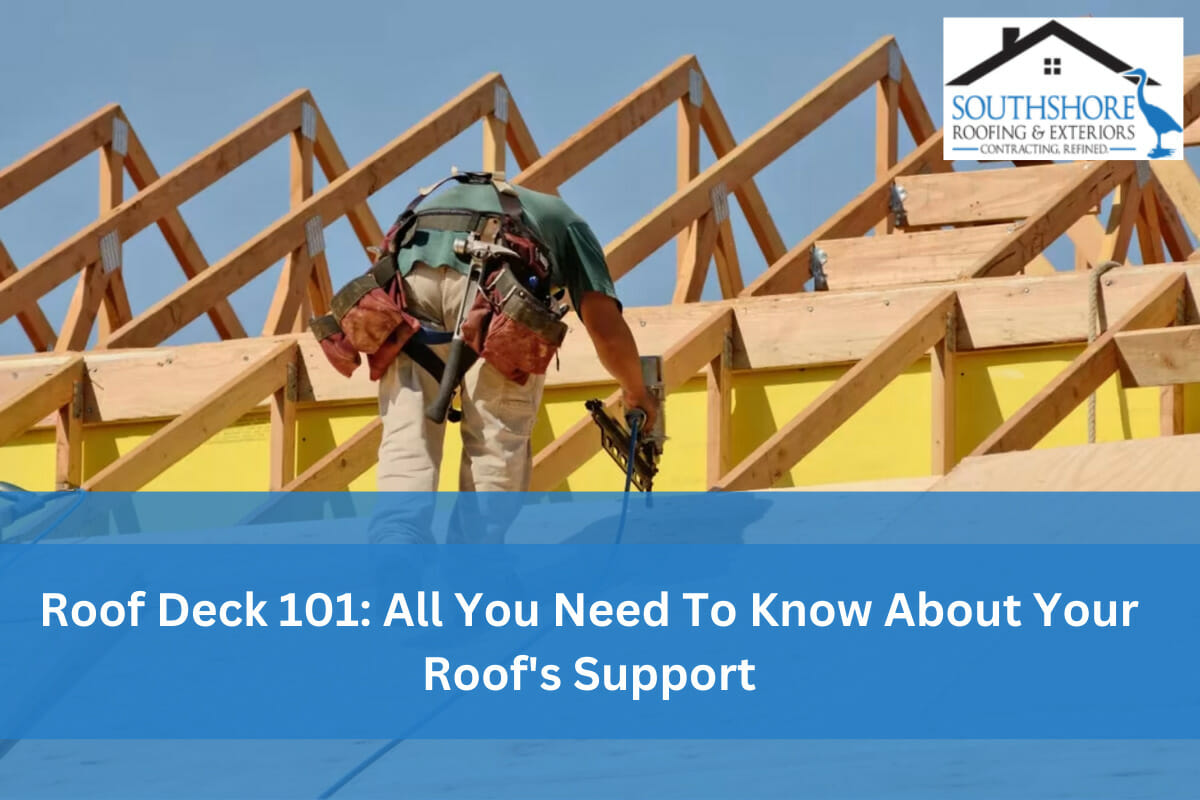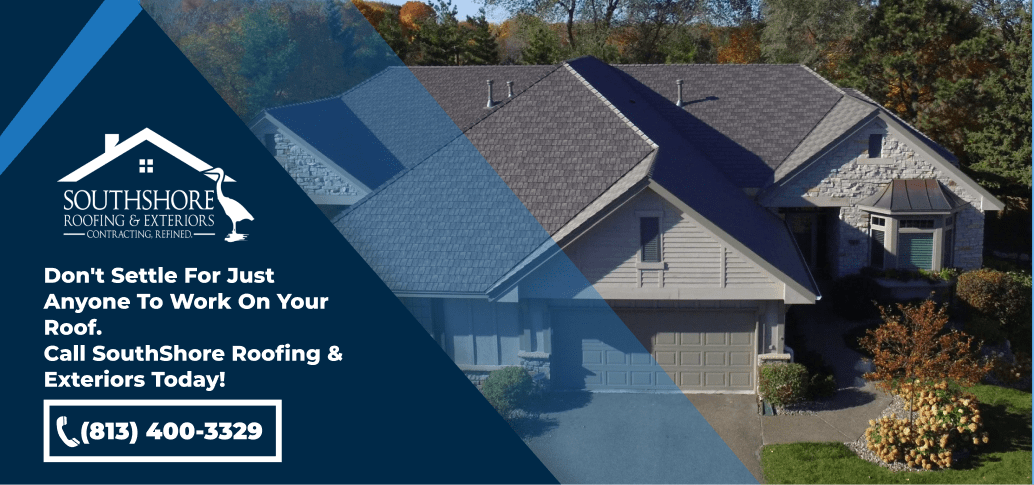The roof deck is an essential component of your roof’s support system. It provides stability and strength to your roof.
While homeowners are aware of the types of roofing materials that can improve their home, they do not know much about the roof deck; the structure on which the materials are installed.
Understanding the basics of the roof deck is vital for homeowners, as it directly affects the performance and longevity of their roofs. In this article, we will delve into the world of roof decks and will explore their importance, popular materials, the installation process, common issues, and maintenance tips.
So, whether you are building a new roof or considering a roof replacement, this article will equip you with the knowledge needed to make informed decisions about your roof’s support system.
What Is A Roof Deck?
So, you’re probably wondering what exactly a roof deck is and why it is so important for your roof’s support. The deck of the roof is the layer of material that the contractor will install on the top of the structural components of your roof, such as the rafters or trusses. It serves as a base for the other parts of a roof, such as underlayment and roofing materials.
The roof deck is also known as roof sheathing. Without a proper deck, your roofing system would lack the necessary support and could be susceptible to structural damage, leaks, and other problems.
The Importance of a Roof Deck
There is a reason why roof decks are on the list of essential roofing components. Be it pitched residential roofs or flat commercial roofing systems, these rectangular wooden boards hold a lot of importance. Here are some of the advantages of properly installed roof sheathing:
Provides Support For The Roof
One of the main reasons why the roof deck is important is because it provides a stable structural foundation for your roof. Without a sturdy deck, your roof can collapse under the weight of the roofing materials. Additional strain from snow, ice, or debris can also cause a roof to sag or cave in, making a strong roof structure even more crucial in areas with severe weather conditions.
Additionally, the roof deck helps distribute the weight of the roof evenly across the supporting structure, which helps prevent any areas from becoming overloaded.
Protects From Roof Leaks
The deck of a roof also protects your home from additional water damage. The roof deck is a barrier against water infiltration and prevents any moisture from seeping into your home. Moisture can cause issues such as rot, mold, or structural damage.
When you install the roof deck properly, you can ensure that your roof remains watertight and protects your home from any potential leaks.
Types of Roof Deck Materials
Just like you have choices when you have to choose the shingles for your roof, there are options in roof deck materials, too. The type of roof decking material you choose will depend on various factors, such as the climate in your area, the slope of your roof, and your budget.
You can divide these wooden boards into two categories: plank sheathing and sheet decking. Currently sheet decking is the most popular option and is used by the majority of homeowners.
Plywood Roof Deck
Plywood is a common choice when it comes to sheet decking. Plywood is essentially layers of wood glued together. It’s a popular option because it’s both affordable and easy to find. Installing plywood isn’t too complicated, and it provides solid support for your roof.
However, it’s important to note that plywood decking may not be the top pick for regions with high humidity or frequent rainfall, as it can be prone to rot and deterioration in those conditions.
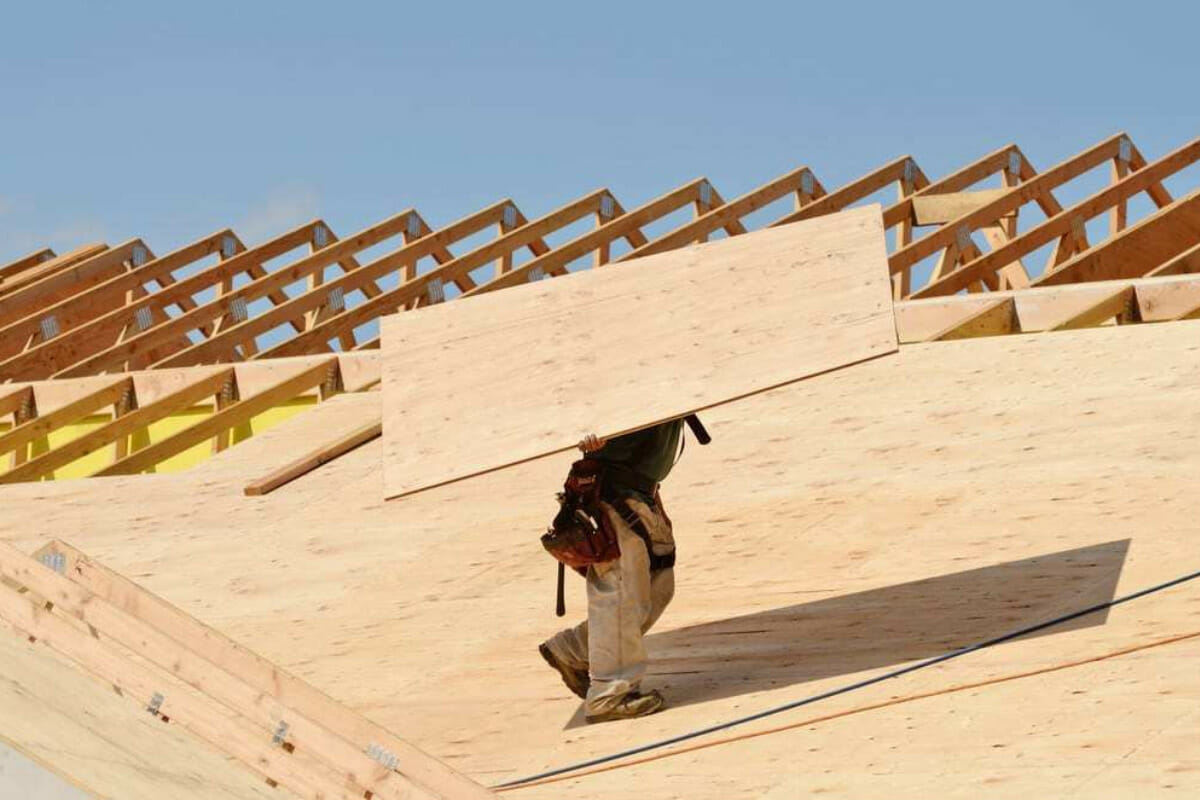
Oriented Strand Board
Another option for a solid roof deck is an oriented strand board (OSB). OSB is also a type of sheet decking and consists of wooden strands bonded together with adhesive and compressed under high pressure. It is a cost-effective alternative to plywood and offers similar levels of strength and durability. However, OSB roof decking is more susceptible to moisture damage than plywood, so it is important to use a moisture barrier or proper ventilation system to prevent issues such as rot or mold. Additionally, OSB can swell and warp if exposed to prolonged moisture, so it may not be the best choice for areas with high humidity or frequent rain.
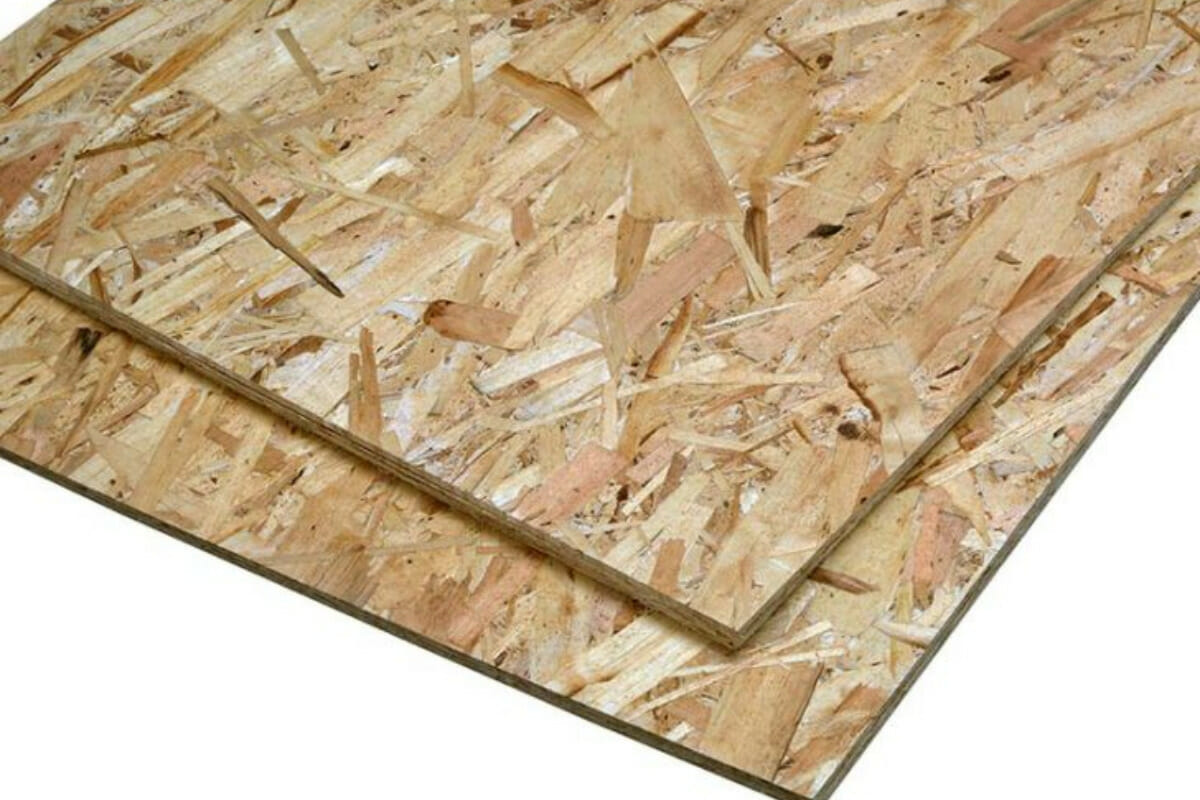
Other Roof Deck Materials
In addition to plywood and OSB, homeowners can also choose from other materials such as metal and concrete. However, these are not as common as the previously mentioned options.
Metal decks, typically made from steel or aluminum, offer excellent durability and fire resistance. It is often used for commercial buildings but can also be a viable option for residential properties.
Concrete roof decks, on the other hand, provide exceptional strength and can withstand extreme weather conditions. It is commonly used in areas prone to hurricanes or heavy snowfall. However, it is important to note that concrete is more expensive and requires professional installation.
Consult with a professional roofing contractor to determine the best option for your home and ensure that your roof’s support system is built to last.
How The Roof Deck is Installed
Now that we know about the materials that we can use for a solid decking, we will explain how it is installed. The installation process of a roof deck involves several steps to ensure a sturdy and secure foundation for your roof.
The following is how professional roofers install the roof deck so you can see how it all comes together:
Step 1: Remove the Old Roofing Materials
The contractor will start by taking off the old roofing materials. This step is very important because it allows them to check the deck underneath. The time required will vary depending on the material, but the process is generally faster for asphalt shingles.
Step 2: Check and Fix Roof Trusses or Rafters
Now, they will take a look at the roof trusses or rafters. If any are weak or damaged, the contractor will fix or replace them to make sure they can handle the weight of the new deck.
Step 3: Get Ready for the New Deck
With the trusses or rafters in good shape, we’re all set for the new roof deck. The choice between a sheet or plank deck will depend on what works best for your roof.
Step 4: Measure, Cut, and Fit
Once the type of decking is decided, it is time to move ahead and measure the material carefully according to the area of your roof. The boards or panels are cut to the right size and fit onto the trusses or rafters.
Step 5: Secure It in Place
After laying the deck on the roof, it’s time to secure it. Nails or screws are used to fasten the boards to the roof structure.
Step 6: Check for Any Issues
After everything is in place, the contractor will look everything over to make sure there are no gaps, loose nails, or other problems. Fixing any issues now makes sure your roof will stand strong for years to come.
Installing the roof deck might sound complicated and risky, which is why hiring a contractor is essential instead of opting for the DIY route. This project requires precision and attention to detail to keep your home safe and dry.
Common Issues You May Face With Your Roof Deck
Now that we’ve covered the installation process, let’s talk about some common issues that arise with a roof deck.
Issue 1: Cracks and Splits
One common issue with roof decks is the development of cracks or splits. This can occur due to the natural expansion and contraction of the wood, especially in extreme weather conditions. It is important to regularly inspect your roof deck for any signs of damage and address them promptly. Cracks or splits can weaken the structural foundation of the roof and lead to leaks or even collapse if left untreated.
Issue 2: Sagging
In some instances, the roof deck may experience sagging or bowing. This issue can arise when the deck lacks adequate support or when it’s exposed to heavy weight over time. A sagging roof deck can create an uneven surface, making the proper installation of roofing materials more challenging and can potentially lead to issues like ponding water.
Issue 3: Water Damage
One of the most common problems associated with roof decks is water damage. Leaks in the roofing system or improper flashing can permit water to infiltrate the deck. This can result in various forms of water damage, including warping or rotting of the decking material and the growth of mold and mildew, all of which can undermine the roofing structure.
Issue 4: Inadequate Ventilation
Roof decks can suffer from moisture related issues if attic ventilation is inadequate. When hot, humid air becomes trapped in the attic, it can cause the deck to absorb excess moisture, potentially leading to problems like delamination and reduced durability. Adequate attic ventilation is essential to regulate temperature and humidity levels, and preserve the health of a roof deck.
If you notice that your roof is sagging and leaking, or you are experiencing an unusual rise in your energy bills, then it could mean your roof deck is damaged. Ultimately, investing in a high quality roof deck will contribute to the overall stability and longevity of your home’s roof.
Conclusion
In conclusion, the roof deck is a crucial part of your roof’s support system. It provides stability and strength to your roof, ensuring its durability and longevity. There are various types of roof decking materials available, each with its own advantages and disadvantages. Additionally, it is important to be aware of common issues that may arise with a roof deck and to follow maintenance tips to prevent any potential problems.
Best Roof Replacement Contractors In Tampa, FL
Remember, investing in a high quality roof deck will not only enhance the structural integrity of your roof but also contribute to the overall safety and value of your home.
If your roof is damaged and you are looking for roof replacement contractors, look no further than the team of SouthShore Roofing & Exteriors.
We are your trusted roofing contractors in Florida, and you can rely on us for the best roof replacement services in the area. We will make sure you have a strong roof deck that can support your entire roofing system, and we can guide you through selecting the most suitable option for your specific needs.
Contact us today at (813) 400-3329 to learn more about how we can help with your roofing project.
Frequently Asked Questions
A. Roof decks can support a significant amount of weight, but the exact capacity depends on factors like the decking material used, its thickness, and the spacing of the support beams. However, regardless of the style of your roof, you should avoid walking on its surface.
A. A roof deck is a crucial component of any roof. It is installed over the rafters or trusses as a level surface. After this, you will need to install the roof underlayment, followed by the roofing material. For proper installation, hire a reputable roofing company for your roofing project.
A. No, it is not always necessary to replace the roof deck when replacing a roof. However, if the deck is damaged or deteriorated, it may need to be replaced to ensure proper support for the new roof. But, in most cases, the deck is only replaced during a roof replacement.
A. Signs of damage or deterioration include sagging or dipping areas, water stains or leaks in the attic, cracked or warped boards, and wood rot. Regular inspections are crucial to identify and address any issues promptly.

